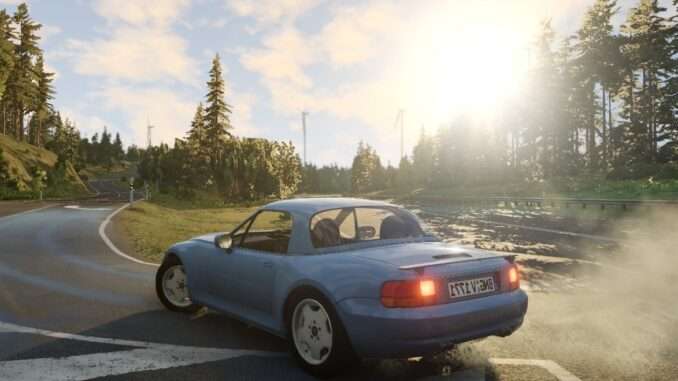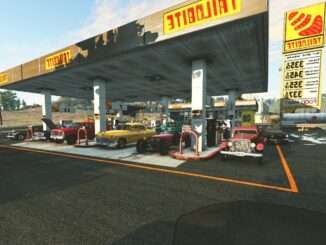
In this guide you will learn how to turn the Civetta Scintilla into a drivable vehicle in the BeamNG.drive 31.2.0.16009 version. (No mods & no programming required).
After completion, the vehicle reaches more than 450 kilometers per hour with stable driving behavior.
This is only a guide for orientation. Fine tuning and improvements through mods or code tuning are not included here.
Input Measurement
The Race (Sequential) Civetta Scintilla version reaches a speed of approx. 325 kilometers per hour.
- 1 – 100 in 3.17 seconds (44 meters)
- 320 – 0 in 6.17 seconds (239 meters)
Unfortunately I could not perform a 100-200 & 200-300 test.
The handling in this version is fine. It can happen that the vehicle breaks out at the rear at higher engine speeds.
With the tuned version this will change slightly and still reach a new top speed.
Components
The Civetta Scintilla Race (Seq) version can be used as the basic construction.
The following components are then modified:
Engine
- Rear Subframe -> Engine
- Engine = 5.0L V10 Engine
- Engine Management = Adjustable Race ECU
- Engine Long Block = Ultra Heavy Duty Long Block
- Engine Mounts = Ultra Heavy Duty Engine Mounts
- Intake = Stage 3 Variable Boost Twin Turbocharger System
(Optional)
- Nitrous Oxide System = Nitrous Oxide Injection
- Nitrous Oxide Bottle = Twin 10lb Nitrous Oxide Bottle
- Nitrous Oxide Shot Size = 100kw
Chassis
- Transaxle = 7-speed dual-clutch transmission
- Transfer case = RWD output shaft
(Optionally, the Clutchex Race all-wheel drive version can also be used for fine tuning).
- Rear differential = Race limited slip differential
- Rear final drive = Race Adjustable Rear Final Drive
- Rear half shafts = Rear Halfshafts
- Rear suspension = Independent rear suspension
- Rear coilovers = Adaptive Achslift rear coilovers
- Rear track bar = Race Adjustable Rear Sway Bar
- Front suspension = Independent front suspension
- Front coilovers = Race front coilovers
- Front differential = Empty
- Front sway bar = Race adjustable front sway bar
Tires & Wheel Alignment
- Tire & wheel alignment is the most important issue for stable handling.
- Front Hub = 5-Lug
- Front Wheels = 20×9 Okudai PR02 Front Wheels
- Tires that are too wide result in poor cornering performance.
- Back hub = 5-lug
- Back Wheels = 19×12 Dreid C70-2-D Rear Wheels
- Rear wheels should be wider and larger tires to get more power on the road.
The following settings were made for the axles in the tuning section:
Front
- Camber Adjust = 18%
- Caster Adjust = 0%
- Toe Left / Right Trim = 0%
- Toe Adjust = -28%
Rear
- Camber Adjust = 23%
- Toe Adjust = 47%
Tire Pressure
- Front = 28 psi
- Rear = 22 psi
- Wheel Offset = none
Brakes
Carbon-Ceramic front and rear.
Aerodynamics
Unfortunately, in my tests I couldn’t detect many differences at high speeds.
In the Dark Owl variant, I couldn’t find any measurable differences in handling. Even lowering the suspension did not produce any downforce effects for me. If there are any professional tuners here, please let me know.
The spoiler version also showed no changes in driving or braking behavior.
Other Tuning Settings
Reduce the fuel tank for weight reasons. The exhaust system can also be removed. Theoretically, all add-on parts that provide aerodynamics could also be removed, but I did not try this in my test.
Differentials
- Final Drive Gear Ratio = 3.6 : 1
- Power Lock Rate = 40%
- Coast Lock Rate = 20%
- Pre-load Torque = 205 N/m
Engine
- RPM Limit Cute Time = 0.15s
- RPM Limit = 9000 rpm
- Wastegate Pressure = 22 psi
(Especially with the wastegate pressure, a reduction leads to significantly less breakout in the rear, even if smaller performance losses have to be accepted here).
Nitro Oxide
- Minimum gear = 4th gear
- Minimum RPM = 3000 rpm
Suspension
Front
- Anti-Roll Spring Rate = 80000 N/m
- Bump Damping = 10300 N/m/s
- Rebound Damping = 20400 N/m/s
- Spring Rate = 185000 N/m
- Spring Height = -0.015 m
Rear
- Anti-Roll Spring Rate = 25000 N/m
- Spring Height = -0.01 m
Breaks
- Front / Rear Bias = 54%
- Breake Force Multiplier = 100%
Conclusion
Output Measurement:
- 1 – 100 in 3.26 seconds (44 meters)
- 454 – 0 in 8.97 seconds (472 meters)
With these settings, the vehicle can be controlled confidently at all speeds. In my tests, I found that the vehicle veers slightly to the left at 7000 rpm in 3rd gear. This is very easy to compensate for, even with the keyboard.
I am not a professional tuner, so the result will not be 100% perfect. However, the vehicle is significantly faster and more drivable than before.

Testing Map: C1 Tokyo Expressway Shutokow
Helpful Shortcuts:
- Control + E = Cars
- Control + W = Tuning
- Alt + U = hide UI



Be the first to comment